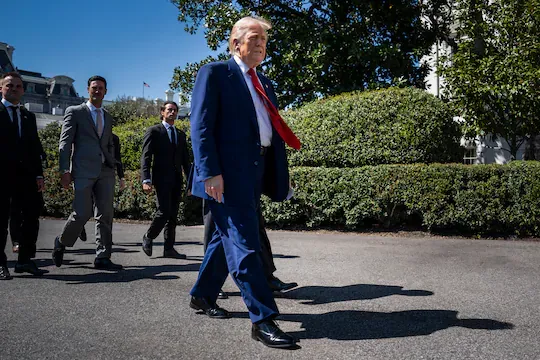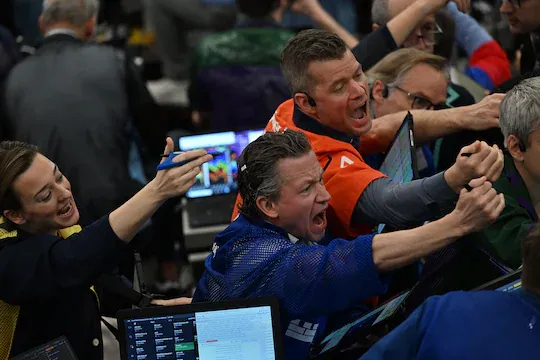On a seemingly ordinary Wednesday in April 2025, the global financial landscape trembled, then roared back to life. In a span of just 18 hours, U.S. President Donald Trump shifted gears on a trade policy that had ignited chaos across international markets, proving once again his knack for dramatic, unpredictable turns. What began as a bold gamble to reshape global commerce with the highest tariffs in over a century ended—at least temporarily—with a partial retreat that sent stock markets soaring and left analysts scrambling to decode the implications. This article dives into the whirlwind of events, unpacks the economic fallout, and explores what this pivot means for America and the world, backed by fresh statistics and insights.
A Bold Vision Meets Market Mayhem
The story kicked off earlier in April when Trump unveiled a sweeping tariff regime aimed at reversing decades of globalization. On April 2, 2025, he announced a baseline 10% tariff on all imports, with steeper rates—some as high as 50%—targeted at specific nations like China, Japan, and the European Union. The move, framed as a “declaration of economic independence,” was rooted in Trump’s long-standing promise to prioritize American manufacturing and reduce trade deficits. By April 9, the policy had escalated, with tariffs on Chinese goods hitting a staggering 104%, alongside hefty duties on allies like Switzerland (31%) and Japan (24%).
The initial impact was seismic. The S&P 500 plummeted 12% in a single week, shedding $6 trillion in value—a loss equivalent to 10% of global GDP. The Nasdaq followed suit, dropping 13.6% from its peak, while Japan’s Nikkei 225 and South Korea’s Kospi indices stumbled by 2% and 1%, respectively, in early trading on April 3. Bond markets flashed distress signals, with U.S. Treasury yields spiking as investors sought safety amid fears of a trade war spiraling into a global recession. According to the Tax Foundation, these tariffs amounted to a $1,900 tax hike per U.S. household in 2025, the largest since 1982, threatening to erode consumer purchasing power.
Trump’s team initially stood firm. A senior White House official dismissed Wall Street’s panic, arguing that “Main Street” still supported the president’s vision. Peter Navarro, a key trade adviser, called the tariffs a “national emergency” response to decades of unfair trade practices, projecting confidence in a manufacturing renaissance. Yet beneath the bravado, cracks were forming.
The 18-Hour Turning Point
The tide began to turn late Tuesday, April 8, 2025. After watching Fox News’ Sean Hannity host a panel of Republican senators, Trump engaged in an hour-long phone call with several GOP lawmakers, including Ted Cruz, Lindsey Graham, and John Neely Kennedy. The senators, fresh from the broadcast, voiced alarm over the economic turbulence. Cruz warned of a “terrible outcome” if retaliatory tariffs from allies like Canada and the EU escalated, citing potential harm to states like Texas, which exports $20 billion in goods to Mexico annually. Kennedy, seizing a moment on air, pleaded for Trump to reconsider, a sentiment echoed in their post-show discussion.
Simultaneously, foreign leaders piled on the pressure. Swiss President Karin Keller-Sutter, reeling from a 31% tariff on her nation’s luxury goods, held a 25-minute call with Trump on Wednesday morning, highlighting Switzerland’s role in supporting 500,000 U.S. jobs and its recent tariff cuts on American industrial imports. Across the Atlantic, EU trade official Maros Sefcovic signaled a counterstrike, approving retaliatory duties on U.S. steel and aluminum aimed at Trump’s voter base—soybean farmers, plastics producers, and more—while hinting at broader measures if talks failed.
Back home, economic heavyweights added fuel to the fire. At 8 a.m. on Wednesday, JPMorgan Chase CEO Jamie Dimon warned Fox News viewers of a looming recession, noting widespread cutbacks among businesses and consumers rattled by the uncertainty. “If we don’t make progress, it could get worse,” he cautioned, a stark reversal from his earlier, more tempered stance on tariffs in January. Trump, an avid TV watcher, took note.
By midday, the Oval Office buzzed with urgency. Treasury Secretary Scott Bessent and Commerce Secretary Howard Lutnick huddled with Trump, crafting a policy shift that blindsided even some White House insiders. At 1:18 p.m., Trump fired off a Truth Social post that rewrote the narrative: a 90-day tariff pause and a reduced 10% rate for most countries, coupled with a jaw-dropping 125% levy on China. “BE COOL!” he had urged hours earlier, followed by “THIS IS A GREAT TIME TO BUY.” The markets listened.
The Aftermath: Boom and Bewilderment
The response was electric. The S&P 500 surged 9.5%—its biggest single-day gain since the pandemic—while the Dow rocketed up 2,962 points, erasing days of losses. Japan’s Nikkei soared nearly 9% on Thursday, April 10, as Asian markets caught the wave of relief. Gold, which had hit $3,167 per ounce amid the tariff chaos, dipped to $2,984, while oil stabilized at $57 per barrel after a 7% plunge. Bitcoin, despite a 30% drop since Trump’s January inauguration, ticked upward from $77,000.
Yet the jubilation masked lingering questions. White House aides scrambled to clarify the new plan’s details—would Canada and Mexico, already under 25% fentanyl-related tariffs, face the 10% levy too? Bessent’s press conference offered little clarity, leaving diplomats and staff guessing. A senior foreign diplomat, informed of the shift via a reporter’s text, described the chaos as “unprecedented.” Even Navarro, sidelined from the Oval Office talks, put on a brave face, calling it a “beautiful negotiation” on Fox Business.
Economists weighed in with mixed verdicts. The Tax Foundation estimated that the original tariffs would have slashed U.S. GDP by 0.8% and raised $2.2 trillion over a decade, with imports dropping 30% ($990 billion) in 2025 alone. The reversal softened that blow, but the 125% China tariff promised ongoing friction. Oxford Economics pegged the global recession risk at 60% pre-reversal, up from 40%, a figure likely tempered by Trump’s pivot. Still, critics like University of Michigan’s Justin Wolfers warned of stagflation—high inflation paired with stagnant growth—if broad tariffs returned.
What It Means for America and Beyond
Trump’s about-face reveals a strategy as fluid as it is bold. By dialing back tariffs on allies while doubling down on China, he’s betting on isolating Beijing economically while coaxing concessions from others. The 90-day pause opens a window for negotiations—Japan and South Korea have already dispatched delegations, and the EU is pushing a “zero-for-zero” deal on industrial goods. Canada, spared the worst, faces pressure to align with U.S. demands on drug trafficking, with 25% auto tariffs still in play.
For U.S. consumers, the respite may delay price hikes. The National Association of Home Builders warned that pre-reversal tariffs on Canadian lumber and Mexican gypsum could have added $2,700 to new car prices and jacked up housing costs. Now, with duties eased, families might dodge a 10-20 cent per gallon gas spike and steeper grocery bills—70% of U.S. winter produce comes from Mexico. Yet China’s retaliation, including 10-15% tariffs on U.S. agricultural exports, threatens farmers in states like Iowa, where soy exports topped $17 billion in 2024.
Globally, the pivot reshapes alliances. Germany’s Robert Habeck, acting economy minister, sees hope in a united European front pressuring Trump to rethink trade barriers. Japan, facing a 24% tariff pre-reversal, plans 1,000 support offices for affected firms, while Thailand urges exporters to diversify beyond the U.S. market, which absorbed $5 billion in New Zealand goods alone in 2024. Lesotho’s textile sector, employing 40,000, braces for collateral damage from disrupted supply chains.
The Bigger Picture: Chaos or Genius?
Was this Trump’s masterstroke or a frantic retreat? Aides like Stephen Miller hailed it as “brilliant tactical planning,” crediting Trump with reforming trade in days. Critics, however, see a policy thrown together “from the heart,” as Trump admitted, lacking the rigor of traditional trade talks. The International Emergency Economic Powers Act (IEEPA), invoked for the tariffs, faces legal scrutiny—its first use for broad import duties has sparked constitutional debates.
Statistics paint a complex legacy. U.S. trade deficits hit $1.2 trillion in 2024, with China ($405 billion), Canada ($67 billion), and Mexico ($152 billion) leading the pack. Trump’s first-term tariffs cut Chinese imports by $380 billion, per the U.S. International Trade Commission, but raised consumer costs by 0.2% annually. This time, the stakes are higher—retaliation from China, the EU, and others could slash U.S. exports ($330 billion already targeted) and ignite inflation, projected at 1.5% higher in 2025 by the Tax Foundation.
For everyday Americans, the lesson might be simpler: markets move on sentiment as much as policy.
Trump’s “SIMPLE LOGIC” rant on trading stocks—shunning expert noise for gut instinct—echoed his tariff flip. When he tweeted “NOW IS THE BEST TIME TO BUY” pre-recovery, he wasn’t wrong. The Dow’s 2,962-point leap proved it. Whether that luck holds as trade talks unfold remains the trillion-dollar question.
As April 10, 2025, dawns, the world watches Trump’s next move. Will the 90-day truce yield blockbuster deals, or will China’s 125% tariff wall reignite the war? One thing’s clear: in 18 hours, Trump turned economic dread into cautious hope, leaving a legacy as volatile as the markets he commands. For now, the rollercoaster pauses—but the ride’s far from over.

